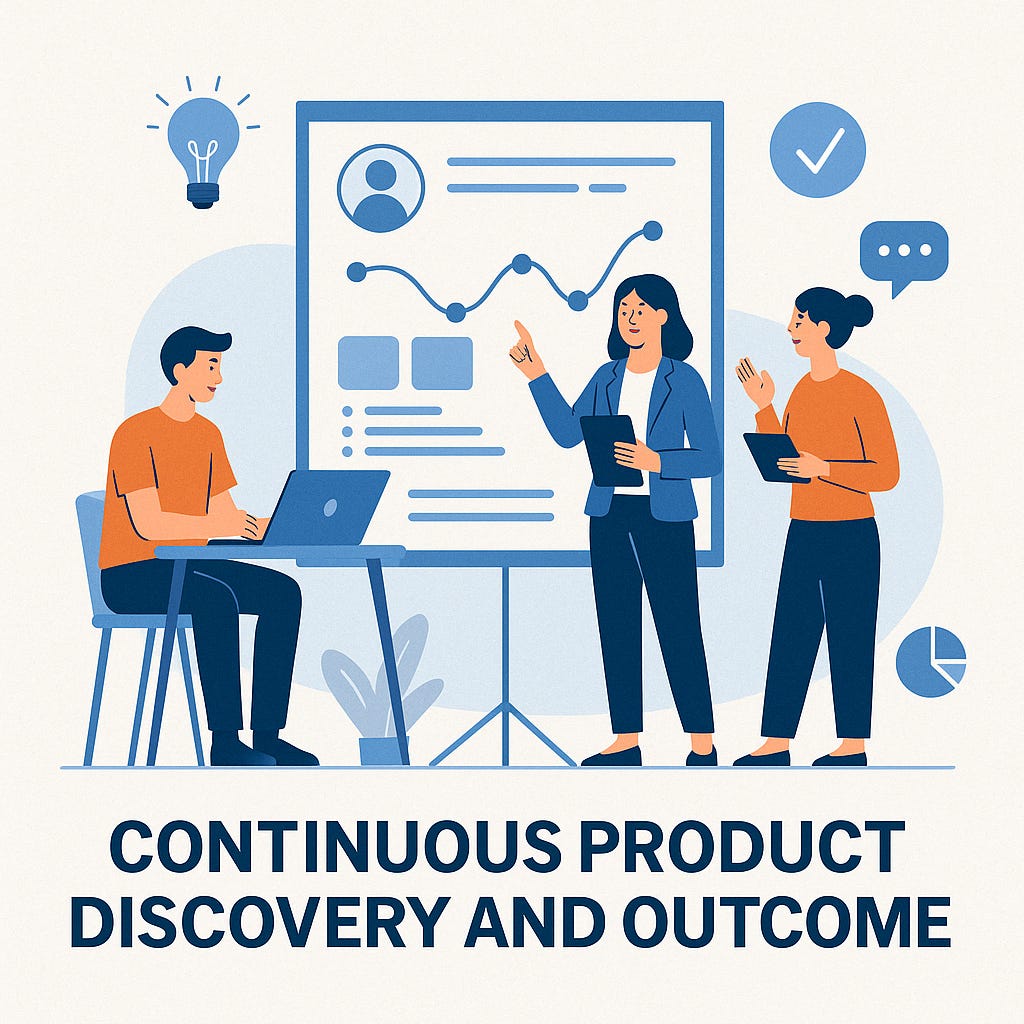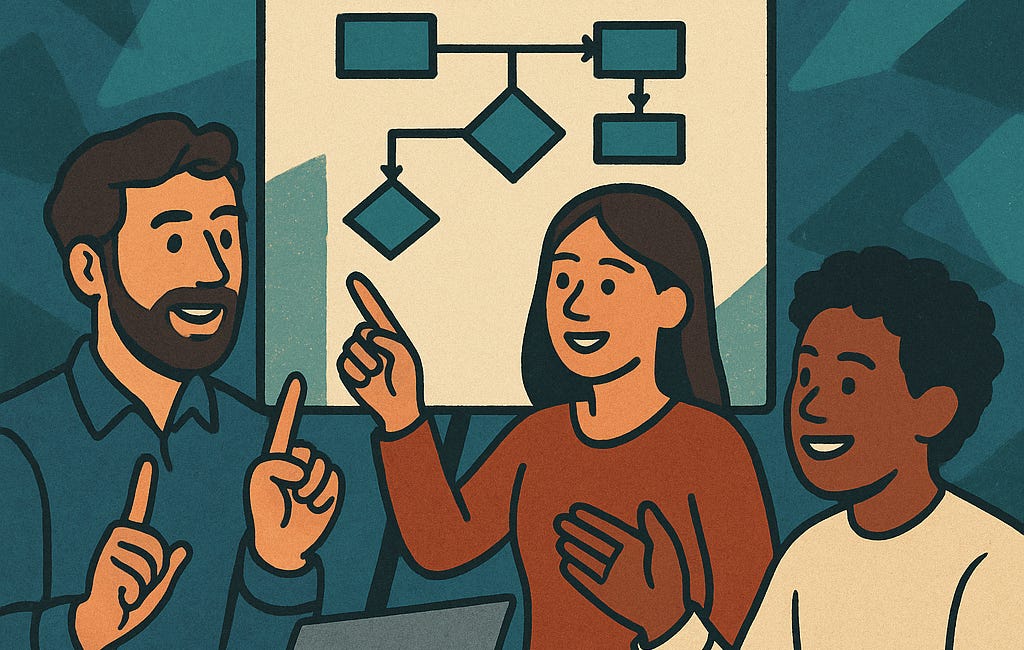Continuous Product Discovery: From Features to Real Outcomes
Why Business Analysts Must Think Beyond Delivery
Think about the last time your team launched a new feature with excitement.
The dashboards were polished, the release notes sent out, and the “go-live” moment felt like a win. But a few weeks later, usage numbers barely moved. Customers kept doing things the old way, or worse, ignored the feature altogether.
It wasn’t a failure of delivery — the team built exactly what was planned. It was a failure of discovery. Nobody had paused to ask: “Does this really solve a problem users care about?”
That’s the gap continuous product discovery is designed to close. It shifts the conversation from “What can we build?” to “What will truly make a difference?”
In this article, we’ll show how business analysts can move from delivering features to delivering real results.
Introduction: From Requirements to Results
In the past, business analysts (BAs) would gather requirements upfront, transform stakeholder requests into documents, and pass them on to delivery teams. But the modern reality is more complex.
That’s why forward-thinking teams are moving toward Continuous Product Discovery — a collaborative, experimental, and iterative approach to uncovering what users really need — and combining it with Outcome-Focused Analysis, which measures whether those needs are truly met.
What Is Continuous Product Discovery?
Continuous Product Discovery is the habit of staying close to users — not just at the beginning of a project, but throughout the entire product lifecycle. It means teams don’t just collect requirements once and lock them in; instead, they keep testing, learning, and adjusting as they go.
As product discovery coach Teresa Torres defines it:
“Continuous discovery means weekly touchpoints with customers by the team building the product, where they conduct small research activities in pursuit of a desired outcome.”
The shift here is subtle but powerful. Instead of documenting what users say they want, the goal is to uncover:
What problem are they really trying to solve?
What’s currently frustrating, inefficient, or broken?
What behavior or outcome would signal that we’ve solved it?
Discovery isn’t about creating perfect specs. It’s about building a feedback loop where teams can spot assumptions early, test ideas quickly, and adjust direction before investing heavily in delivery.
So how do teams actually practice continuous discovery? Here are some of the most effective techniques business analysts can bring into their daily work:
🔁 Key Practices in Continuous Product Discovery
Customer Interviews – Short & frequent conversations with real users (ideally once per week) to surface problems and validate assumptions.
Journey Mapping – Visualizing end-to-end experiences to highlight pain points, friction, and opportunities for improvement.
Rapid Prototyping – Building low-fidelity sketches or clickable demos to test ideas before any code is written.
A/B Testing & Data Analysis – Running small experiments and measuring real user behavior to learn what actually works.
Opportunity Solution Trees (OSTs) – Mapping outcomes to opportunities, and opportunities to multiple solution ideas, ensuring teams explore more than one path.
You’ll agree that theory is useful, but I’m often asked how to apply it in practice — so here are some sector-based examples.
Examples from Practice
🏦 Banking & Finance
A BA on a banking team notices high drop-off during the online loan application process.
Instead of adding another support feature, they run interviews and discover users feel overwhelmed by form complexity. Partnering with design, they prototype a simplified version. Result: 15% increase in conversions — not by building more, but by removing friction.
🎧 Media & Entertainment
At Spotify, continuous discovery practices helped shape Discover Weekly. The team tested early prototypes with small user groups, validating that personalized playlists would keep people engaged. The outcome wasn’t just a feature, but a massive boost in user retention.
🛠 Productivity & Collaboration
At Atlassian, discovery is deeply embedded. Teams run lightweight weekly interviews, visualize insights with Opportunity Solution Trees, and test assumptions in Miro before committing to delivery. This ensures every idea is traced back to a measurable outcome.
📊 What Is Outcome-Focused Analysis?
As I mentioned earlier, continuous discovery and outcome-focused analysis are two sides of the same coin.
Discovery helps us uncover what might work for users — but outcome-focused analysis tells us whether it actually did.
It’s the discipline of tying all product activities to measurable results.
Instead of asking:
“What do stakeholders want us to build?”
You ask:
“What change in user behavior or business metric are we aiming for?”
🔁 Key Practices in Outcome-Focused Analysis
Defining Success Metrics / OKRs – Set clear, measurable outcomes before starting work.
Tracking User Behavior – Monitor usage patterns to see if the desired change happens.
Running Validation Loops – Compare expected vs. actual impact, and adjust direction.
Framing Hypotheses – Treat every feature as a testable bet instead of a guaranteed solution.
Examples from Practice
🏦 Banking & Finance
A digital bank hypothesizes that simplifying its sign-up form will increase activation rates.
Hypothesis: Cutting unnecessary fields will raise trial activation by 20% within 30 days.
Outcome: Success is measured if at least 50% of new sign-ups reach step 3 of onboarding.
💬 SaaS & Customer Communication
Intercom defines both customer outcomes (higher engagement) and business outcomes (lower churn) for each initiative. They keep measuring long after launch — ensuring features drive behavior change, not just delivery.
🛍 E-Commerce & Retail
An online retailer frames a hypothesis: “If we introduce one-click checkout, we’ll reduce cart abandonment by 10% in the next quarter.”
By tracking funnel analytics, they validate whether the feature delivers the expected lift in completed purchases.
🛠 Productivity & Collaboration
At Atlassian, outcome analysis is tied into product strategy. Teams use OKRs to frame expected impact (e.g., “increase active collaboration in Jira by 15%”) and run validation loops against actual usage data.
👩💻 The Role of the Business Analyst
In this new landscape, the Business Analyst is no longer just a translator of requirements.
They’ve become a co-creator of learning — helping teams discover, test, and validate what really drives value.
Instead of simply documenting what stakeholders say, BAs now take on a more dynamic role:
Design discovery activities together with product managers and UX teams.
Frame assumptions as hypotheses that can be tested, not just recorded.
Use feedback and data to continuously refine requirements.
Connect features to outcomes, ensuring every item in the backlog links to business goals.
Maintain traceability between discovery insights and delivery execution.
In other words, rather than producing static documentation, the BA becomes a sense-maker — someone who connects business needs, user realities, and delivery outputs into a coherent picture.
To thrive in the world of continuous discovery and outcome-driven analysis, Business Analysts need a toolkit that goes beyond documents and spreadsheets.
🛠 Tools and Techniques for Modern BAs
Here are some of the most useful tools and techniques:
✏️ Discovery Tools
Dovetail / Aurelius – Capture user interview notes, tag insights, and highlight emerging themes.
Miro / MURAL – Build journey maps, pain-point boards, and opportunity-solution trees collaboratively.
Maze / Useberry – Test prototypes with real users and collect early feedback.
FigJam – Run interactive workshops and map insights in real time.
ChatGPT / Claude – Summarize interview data, spot patterns, and even generate solution ideas for further exploration.
📊 Outcome Analysis Tools
Amplitude / Mixpanel – Track user behavior, funnels, and conversion rates.
Google Analytics / Hotjar – Understand patterns, drop-offs, and on-page heatmaps.
Productboard / Aha! – Connect features directly to user needs and measurable outcomes.
Jira Product Discovery – Prioritize and visualize opportunities linked to specific outcomes.
Together, these tools help the BA act as a bridge between discovery and delivery — making sure insights don’t just sit in workshop notes, but flow into validated, outcome-driven decisions.
👉 Liked what you’re reading? You might also enjoy our article Collaborative Modeling: Turning Complexity into Clarity.
Collaborative Modeling: Turning Complexity into Clarity
Have you ever tried assembling IKEA furniture with instructions in another language?
🌍 Practitioner Insights and Case Studies
Before we move to the final thoughts, let’s look at how leading tech companies put continuous discovery and outcome-focused analysis into practice:
Intercom – Defines success as a mix of customer outcomes (e.g., engagement) and business outcomes (e.g., retention). Uses continuous experimentation to measure real behavior change.
Atlassian – Embeds OSTs, lightweight interviews, and shared research boards into daily work. Even launched Jira Product Discovery to help teams manage outcome-driven opportunities.
Spotify – Created Discover Weekly by running small prototypes, testing with users, and validating impact before scaling globally.
Productboard – Promotes “bite-sized discovery” activities and centralizes customer feedback so insights can be reused across teams.
Basecamp – Works in “shaped” cycles (from the Shape Up method) to frame problems clearly and tie outcomes to business goals before delivery begins.
Netflix – Runs constant A/B tests and rapid experiments to validate assumptions about user behavior. From personalized recommendations to streaming features like “Skip Intro,” every change is tested against measurable engagement and retention outcomes.
These stories show that discovery and outcomes aren’t just buzzwords — they’re proven practices shaping how world-class companies deliver value.
We’ll finish today’s article with a few recommended reads — because this topic goes much deeper than we could cover here.
📚 Recommended Reading
If you’d like to dive deeper into these practices, here are some excellent resources:
Continuous Discovery Habits — Teresa Torres
Inspired / Empowered — Marty Cagan
Product Discovery Playbook — Productboard
Outcomes Over Output — Josh Seiden
Final Thoughts
Continuous Product Discovery and Outcome-Focused Analysis reshape how we define, build, and measure success. They shift the analyst’s role from a requirement gatherer to a learning leader — someone who bridges the gap between uncertainty and progress.
As a BA, your most powerful tool isn’t a template or a diagram.
It’s a simple but transformative question:
“How will we know this is working?”
Until next time, happy exploring, and I’d love to hear your thoughts on the topic.



